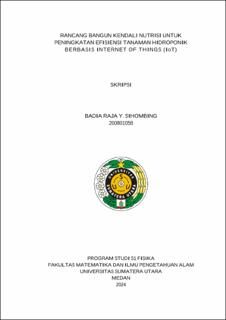Rancang Bangun Kendali Nutrisi untuk Peningkatan Efisiensi Tanaman Hidroponik Berbasis Internet of Things (IoT)
Design and Build of Nutrient Control for Enhancing Efficiency of Hydroponic Plants Based on Internet of Things (IoT)

Date
2024Author
Sihombing, Badia Raja Y
Advisor(s)
Situmorang, Marhaposan
Metadata
Show full item recordAbstract
As the area of agricultural land continues to decrease while the human population increases, the demand for food also rises in parallel. There is a need for planting techniques that do not use soil as a growing medium. Hydroponic cultivation techniques are very suitable for small plots of land, such as urban areas, where there is generally only a limited amount of good soil available for agricultural activities. Therefore, a new innovation in agriculture is needed, which is the cultivation of plants using hydroponics. This technique requires specialized knowledge in the care of plants. With the development of technologies such as the Internet of Things (IoT), it becomes easier for people to produce high-quality plants without having to monitor them constantly. The system created consists of hardware and software components. The system includes four sensors: an ultrasonic sensor, TDS sensor, pH sensor, and turbidity sensor, each having its own specific function. All sensors and actuators are controlled using an Arduino Uno. Based on the testing results, the system can manage nutrients effectively, and the sensors can read data that closely approaches the set points. Experiments conducted to change the set points on the device can achieve values near the target set points. The set point for ppm used in this study is 500 ppm and 800 ppm, with a pH set point of 6.5. The sensor readings can be easily monitored using a smartphone application.
Collections
- Undergraduate Theses [1382]
